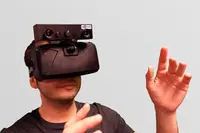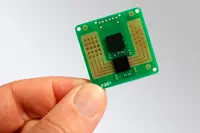Electronics News
Archive : 7 January 2016 год
 Inuitive and Gestigon are collaborating to bring gesture recognition to embedded virtual reality (VR) platforms. The first stage of this collaboration will be demonstrated by both companies at CES 2016 in Las Vegas.
Inuitive and Gestigon are collaborating to bring gesture recognition to embedded virtual reality (VR) platforms. The first stage of this collaboration will be demonstrated by both companies at CES 2016 in Las Vegas.
Moritz Grotthuss, CEO of Gestigon, said: “Using today’s head-mounted VR displays, my hands are either not visible, or the tracking is so slow and inaccurate that the hands feel more like a robot’s and not my own.”
Second generation head-mounted-devices will include front-facing 3D sensors to improve realism, but component cost and power consumption are key concerns.Bringing together the Inuitive NU3000 multi-core imaging processor and Gestigon gesture recognition algorithms, the collaboration between the two companies aims to address these concerns.
The NU3000 processor incorporates two CEVA MM3101 imaging and computer vision vector DSP cores. In addition, it integrates a dedicated hardware accelerator capable of extracting real-time depth maps from stereo vision input. Gestigon’s gesture recognition algorithms, based on its Carnival AR/VR Interaction Suite, are customised and optimised to run directly on this processor to provide fingertip and hand tracking, as well as gesture recognition.
Shlomo Gadot, CEO and co-founder of Inuitive, added: “Our unique technology and architecture uses input from standard, low-cost cameras to efficiently generate depth maps. Now, through our collaboration with Gestigon, we can offer a complete one-stop solution to our customers, shortening the development cycle.”
Author
Tom Austin-Morgan
Source: www.newelectronics.co.uk
 Said to be the smallest such device, a single chip 77GHz radar transceiver from NXP is claimed to enable the ‘next generation’ of radar sensor assemblies and to accelerate the adoption of advanced driver assistance systems (ADAS).
Said to be the smallest such device, a single chip 77GHz radar transceiver from NXP is claimed to enable the ‘next generation’ of radar sensor assemblies and to accelerate the adoption of advanced driver assistance systems (ADAS).
The device, which measures 7.5 x 7.5mm, allows systems to be integrated ‘invisibly’ practically anywhere in a car. This is highlighted as an advantage for engineers looking to design in increasing numbers of sensors. With a power consumption said to be 40% less than conventional radar ICs, the device is believed to have applications in emergency braking, adaptive cruise control, blind spot monitoring, cross traffic alert and automated parking.
Torsten Lehmann, NXP’s senior vice president for infotainment and driver assistance, claimed: “Building the world’s smallest fully integrated 77GHz chip will pave the way for self-driving cars and drive increased ADAS adoption in the volume market.”
Working prototypes of the RF CMOS IC are now with NXP’s lead customers and are being field tested by engineers working on Google’s self driving cars.
Author
Graham Pitcher
Source: www.newelectronics.co.uk

